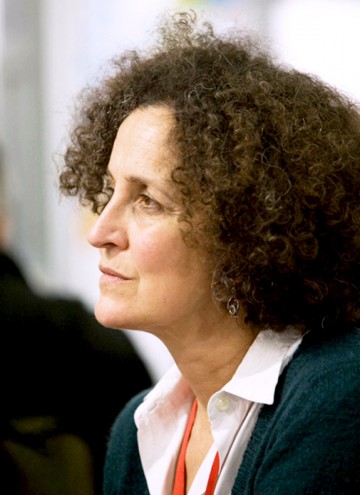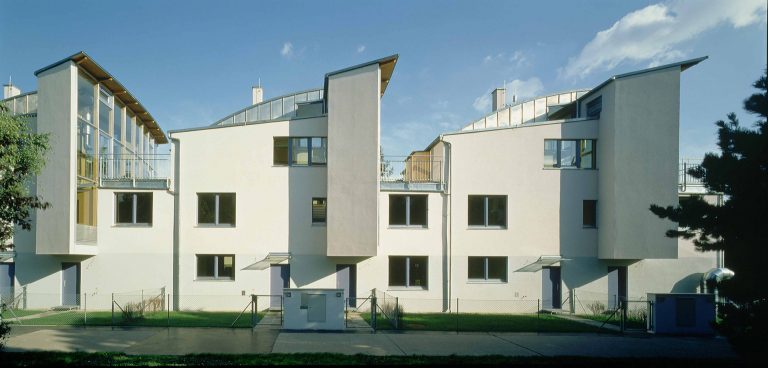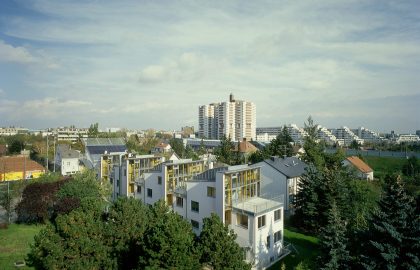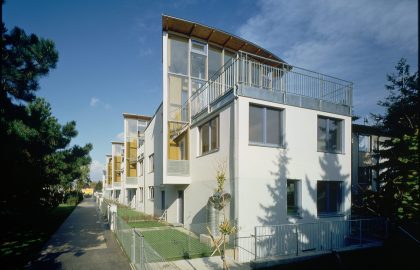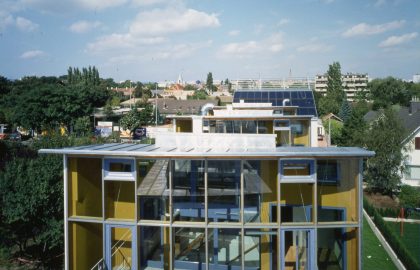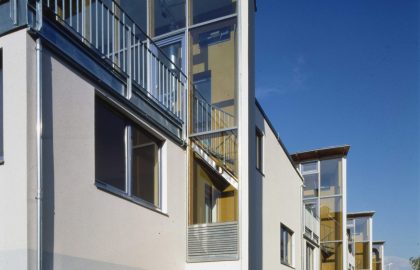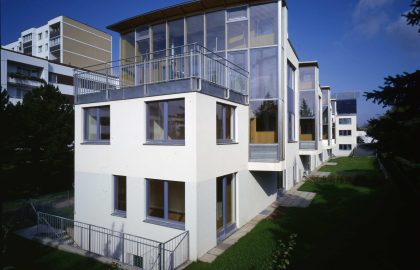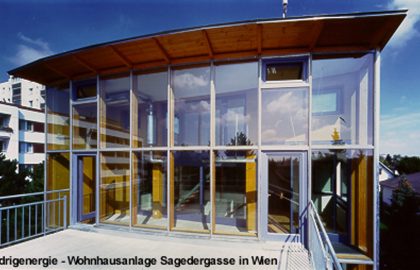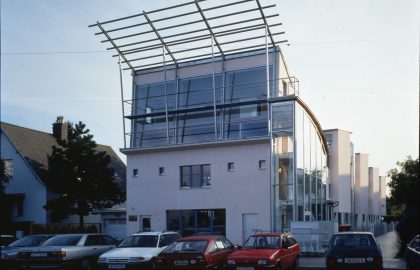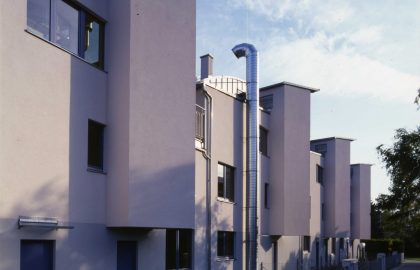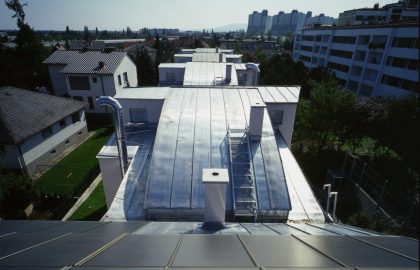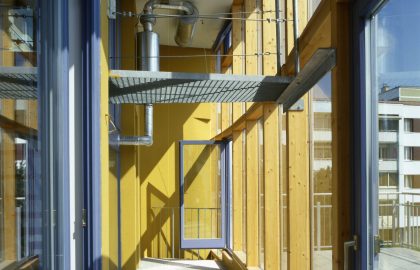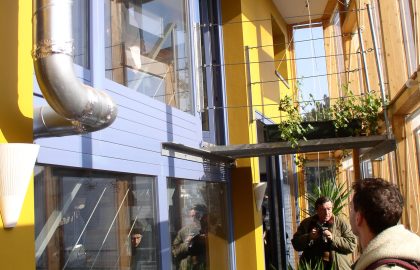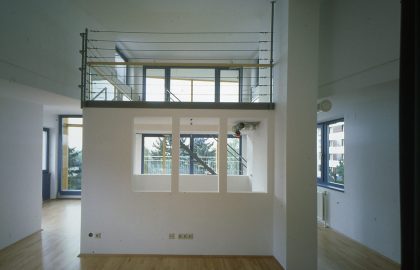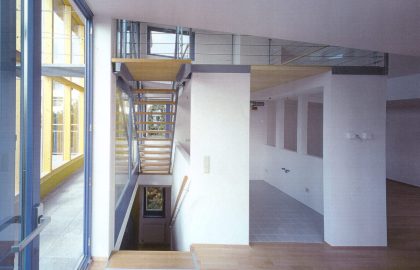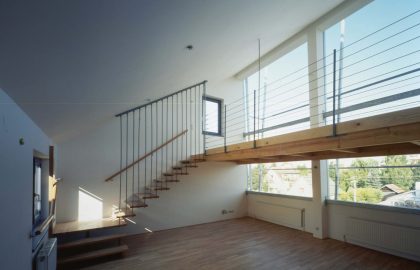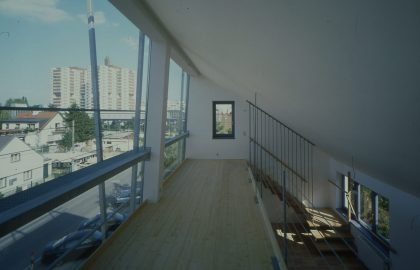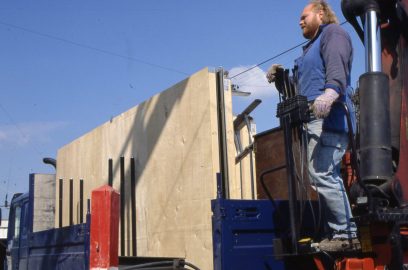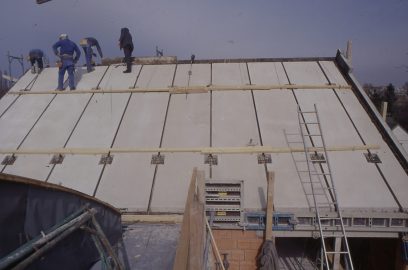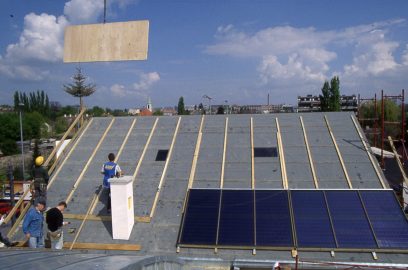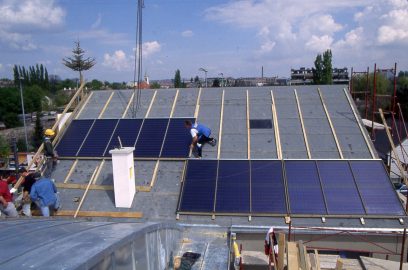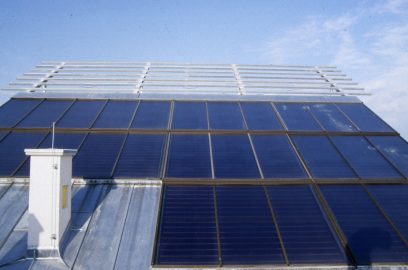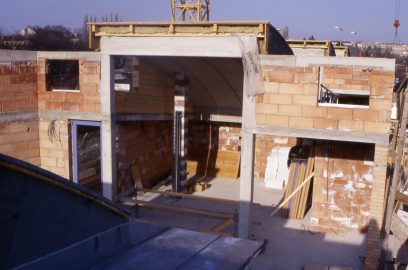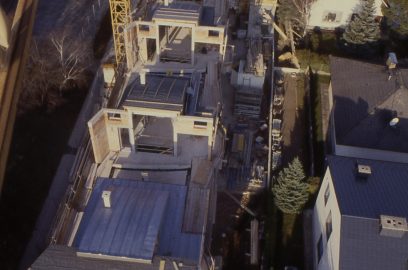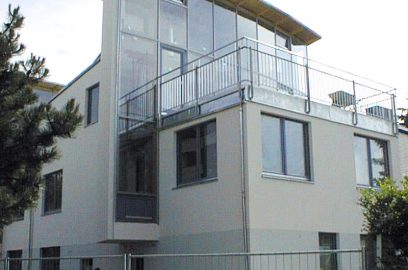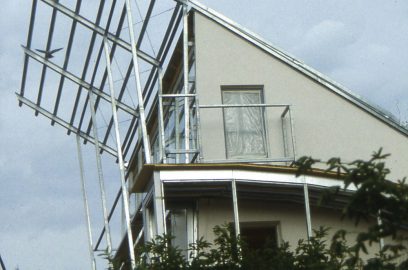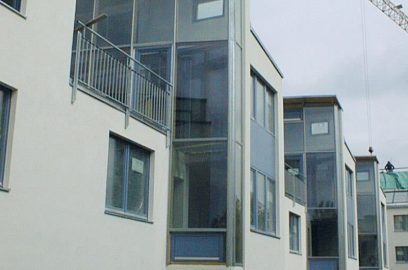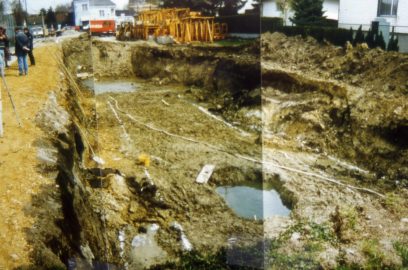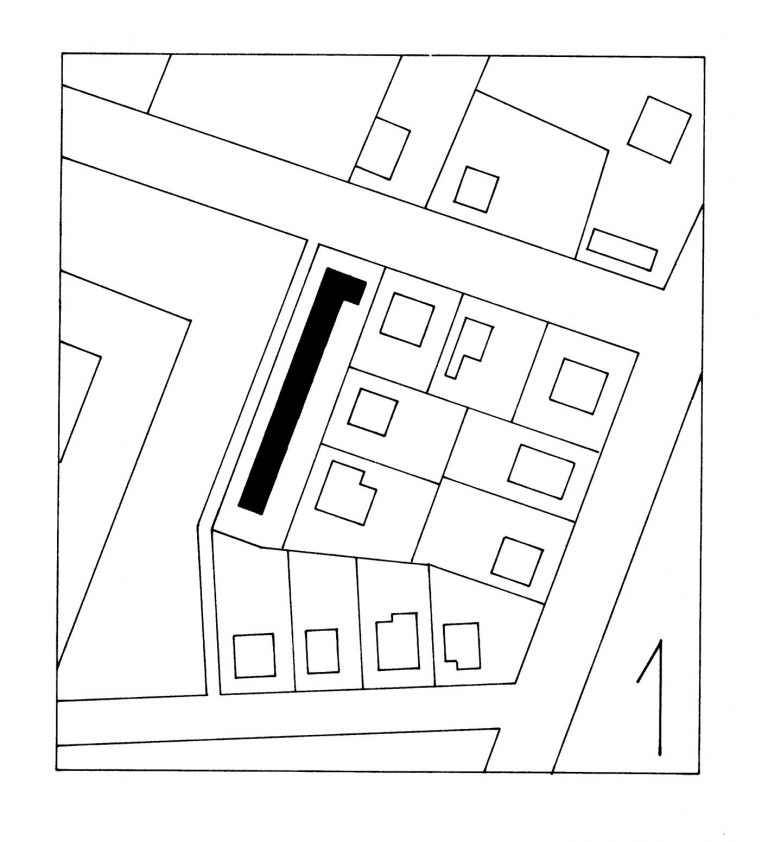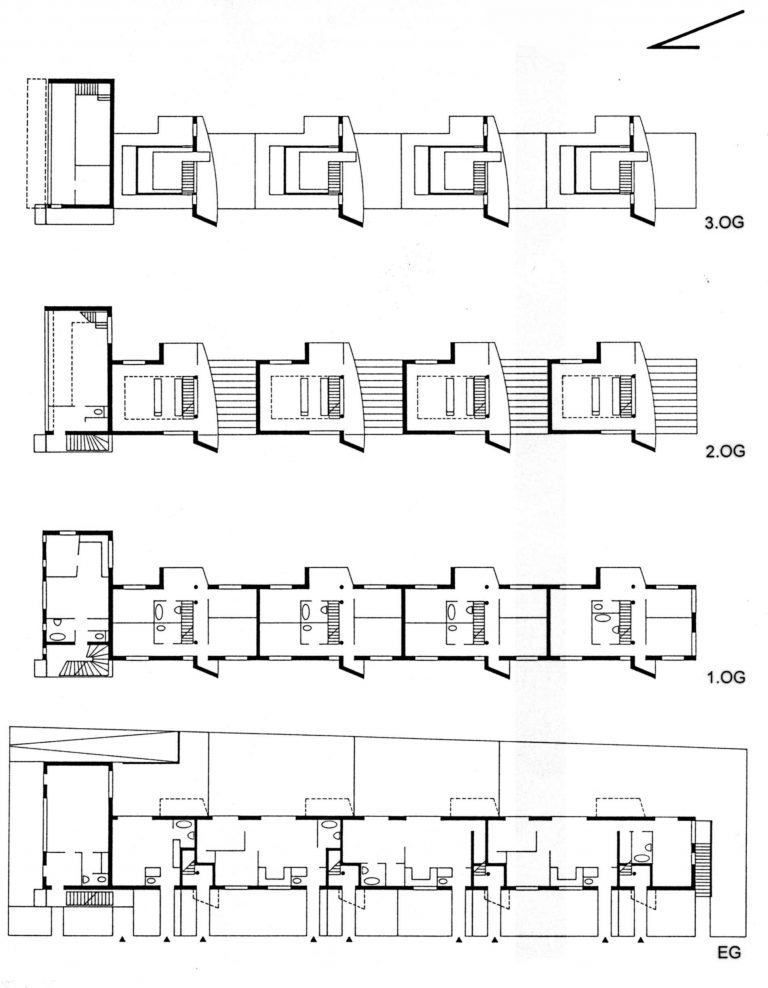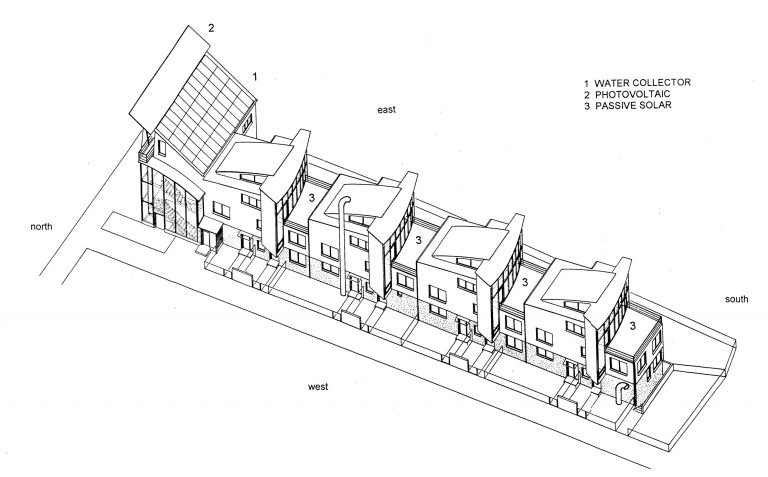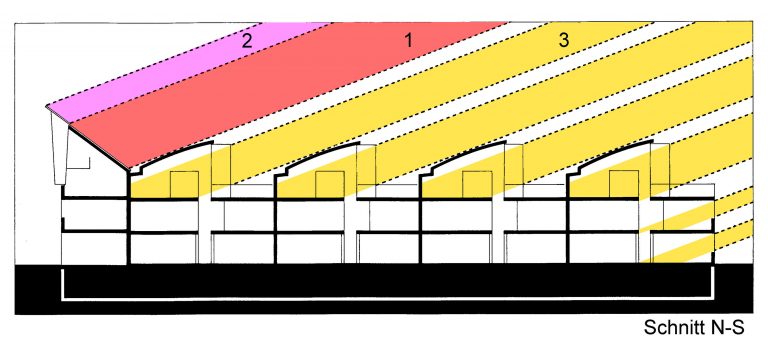The main road Sagedergasse lies on the northern narrow side of the plot. To the east and south, the lot is surrounded by an area of detached single-family houses. To the west, a narrow pedestrian path separates the plot from relatively tall buildings of 5 to 9 storeys. The plot is a typical residual area which was left in a questionable urban situation.
The design creates a building volume large enough to assert itself next to the neighbouring high buildings. The roof-scape of the duplex apartments maintains however the scale of the adjacent single-family dwellings. Likewise, the private gardens are allocated to the apartments on the ground floor. The terraces of the duplex apartments and the individual entrances off the pedestrian path, all have the character of single-family dwellings. On the other hand, the common garage in the basement, the consolidated energy supply and refuse management, present the advantages of collective housing.
Although the longest plot sides are to the east and west, the building orients itself along its full length, to the south. Thus, almost all the incident solar radiation is exploited for thermal energy gain.
In addition to the plot’s confinements, the building code imposed more constraints on the design. Nevertheless, the proposal offered more useable floor area than a conventional solution might do.
The longitudinal building contains on the ground floor, apartments of various sizes which have direct access to private gardens. On the first level, duplex apartments are located whose entrances are located on the ground floor. The first floor houses the bedrooms, a bay window and a sanitary core. An attic accommodates the kitchen above the sanitary unit (toilets, lavatories and bathroom). Facing east, the dining space is located. The living room is situated due north but receives light directly from east/west and indirectly from the south. A gallery (mezzanine floor) is located above the kitchen box. Situated to the south of the attic floor, is a terrace and winter garden (sun space) whose volume extends partially to the bedrooms level below. The individual roofs are a close derivation of a half cone. This specific roof shape optimises the passive solar gain while it minimises the shadow cast behind the roof when the sun’s rays are at low incident angles. This exposure to the sun symbolises an “open Architecture” with all the resulting qualities attributed to daylight. For further optimisation of the passive solar yield, the winter gardens are slightly rounded, skewed to the exact south and cantilevered to the south and west.
The northern part of the project along the main road is a separate building which houses office spaces. Unlike the passive solar use of the housing units, this structure is oriented to the north in order to receive the homogeneous north light. The closed pitched roof surface facing south accommodates the solar hot water collectors. This surface of collectors substitutes the traditional roofing completely. As an extension of the collector’s surface, photovoltaic panels form a cantilevered canopy to protect the glazed north facade from weathering.
Energy concept
Considering the already mentioned plot configurations, an intuitive energy concept was initially adopted, which intends several strategies based on previous experiences. This basic design was then checked with a computer simulation program (TAS). Compared to the basic design, various improvements or savings were tested. The various energy consumption options were calculated. Based on the tender documents of the whole project, bids from manufacturing firms were received. It became possible to compare the computer results according to their respective initial costs and redemption period. The cost factor helped precise decision-making.
Thermal insulation is also here the most important starting point for the energy concept. The optimised heat preservation within the building’s shell is supplemented with a central heat recovery system from exhausted air. The horizontal ducting of the automatic ventilation system is located in the basement. From there, the vertical ducts rise through the installation cores and afterwards, they are contained in the false ceiling void above the corridors and sanitary units (toilets, lavatories and bathrooms).
The passive solar gain from the winter garden (sun space) is transferred automatically into the bedrooms and living room through the existing ventilation system in the sun space. Automatic vents and equipment for air circulation provide good protection against overheating in summer.
The fresh air intake for the ventilation system is drawn through a 48m long pipe, buried underground, with a diameter of 480mm. When passing through this channel, the air is pre-heated in winter and pre-cooled in summer.
The hot water supply is provided in summer almost entirely from the solar hot water collectors (56m² flat collectors, 1,500 litres buffer water storage tank and 500 litres non-potable water storage). Thanks to the substitution of the traditional roofing and the sub-construction for the collectors as well as the use of large collectors (12m²) and a generous public subsidy (25% of the initial cost), the redemption period is expected to be reduced to less than 4 years.
The remaining energy needed for space heating (for example 18.4 kWh/m²/a for the duplexes) is supplied from the district heat main line of Vienna which uses almost entirely recovered heat).
The photovoltaic panels in the form of a canopy function optimally since their underside surface is ventilated. They supply more than double the additional electrical power needed for the alternative heating systems (pumps and ventilators).
Due to the unfavourable orientation of the plot and also the fact that the south side is the shortest, the collector roof and the photo-voltaic canopy exploit the incident sunlight as much as possible, for the energy gain for the housing units. This light would have been otherwise wasted on the street asphalt to the north.
Other utility services
Rainfall is collected in a cistern in order to be used for toilets and for watering plants. Potable water and the remaining electrical power needed are supplied from the public main lines. Discharge from toilets is channelled in the public sewage system.

